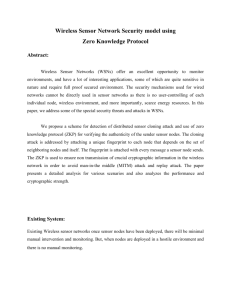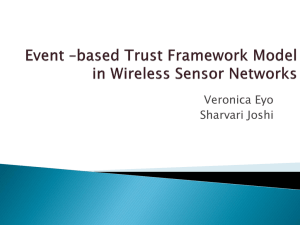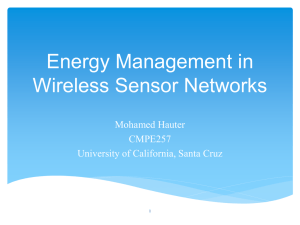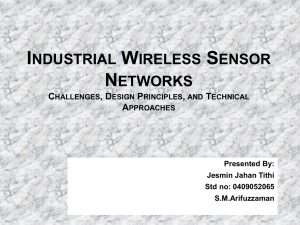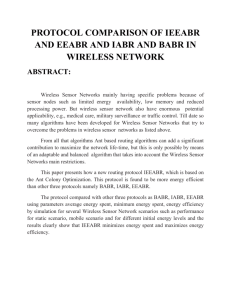File
advertisement
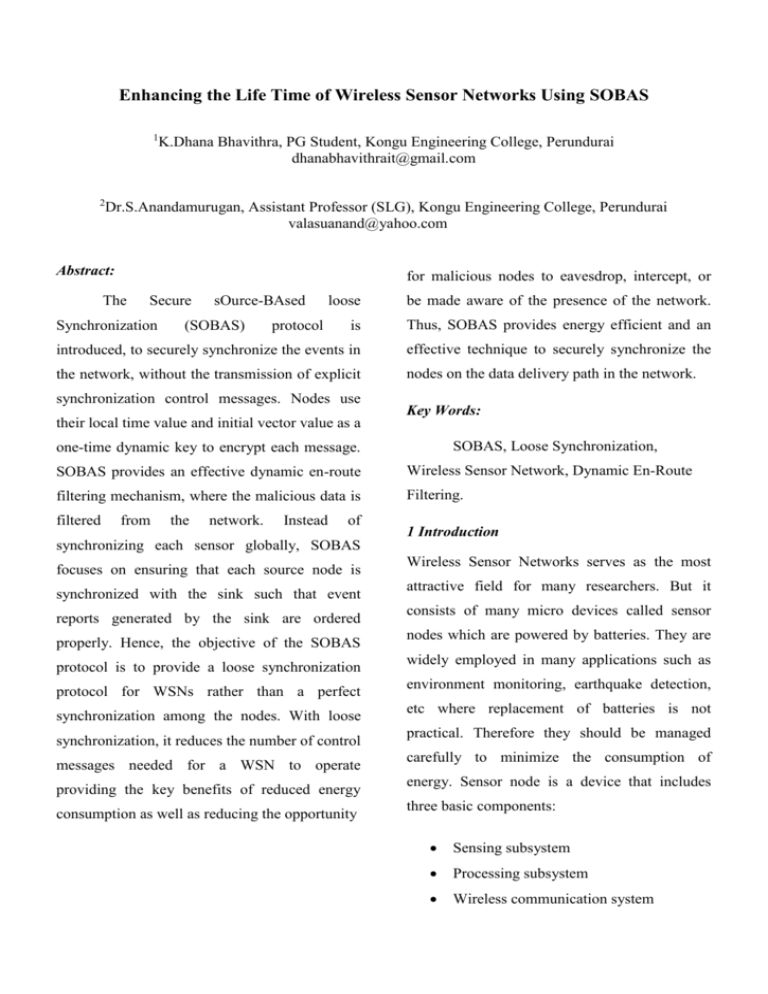
Enhancing the Life Time of Wireless Sensor Networks Using SOBAS 1 2 K.Dhana Bhavithra, PG Student, Kongu Engineering College, Perundurai dhanabhavithrait@gmail.com Dr.S.Anandamurugan, Assistant Professor (SLG), Kongu Engineering College, Perundurai valasuanand@yahoo.com Abstract: for malicious nodes to eavesdrop, intercept, or loose be made aware of the presence of the network. is Thus, SOBAS provides energy efficient and an introduced, to securely synchronize the events in effective technique to securely synchronize the the network, without the transmission of explicit nodes on the data delivery path in the network. The Secure Synchronization sOurce-BAsed (SOBAS) protocol synchronization control messages. Nodes use their local time value and initial vector value as a Key Words: SOBAS, Loose Synchronization, one-time dynamic key to encrypt each message. SOBAS provides an effective dynamic en-route Wireless Sensor Network, Dynamic En-Route filtering mechanism, where the malicious data is Filtering. filtered from the network. Instead of 1 Introduction synchronizing each sensor globally, SOBAS focuses on ensuring that each source node is synchronized with the sink such that event reports generated by the sink are ordered properly. Hence, the objective of the SOBAS protocol is to provide a loose synchronization protocol for WSNs rather than a perfect synchronization among the nodes. With loose synchronization, it reduces the number of control messages needed for a WSN to operate providing the key benefits of reduced energy consumption as well as reducing the opportunity Wireless Sensor Networks serves as the most attractive field for many researchers. But it consists of many micro devices called sensor nodes which are powered by batteries. They are widely employed in many applications such as environment monitoring, earthquake detection, etc where replacement of batteries is not practical. Therefore they should be managed carefully to minimize the consumption of energy. Sensor node is a device that includes three basic components: Sensing subsystem Processing subsystem Wireless communication system public key server directory to allow public key 1.1 KEY sharing. PGP server directory keys may be In cryptography, a key is a variable value updated but not removed. that is applied using an algorithm to a string or block of unencrypted text to produce encrypted 2 LITERATURE REVIEW text, or to decrypt encrypted text. The length of the key is a factor in considering how difficult it Pottie G.J and Kaiser W.J (2000) proposed that the opportunities for Wireless Integrated will be to decrypt the text in a given message. Network Sensors (WINS) depend on the development of scalable, low cost, sensor 1.1.1 Private Key network architecture. This requires that sensor In cryptography, a private or secret key is an encryption/decryption key known only to the party or parties that exchange secret messages. In traditional secret key cryptography, a key would be shared by the communicators so that each could encrypt and decrypt messages. The risk in this system is that if either party loses the key or it is stolen, the system is broken. A more recent alternative is to use a combination of public and private keys. In this system, a public key is used together with a private key. information be conveyed to the user at low bit rate with low power transceivers. Continuous sensor signal processing must be provided to enable constant monitoring of events in an environment. By coming to decisions on these events, short message packets suffice. Future applications of distributed embedded processors and sensors will require massive numbers of devices. Conventional methods for sensor networking would present impractical demands on cable installation and network bandwidth. Through processing at source, the burden on 1.1.2 Public Key communication system components, networks, A public key may be placed in an open and human resources are drastically reduced. access directory for decryption of the digital The physical considerations that lead to the signature of the sender; the public key of the design of densely distributed sensor networks, message recipient message. Public encrypts Key the sender’s Infrastructure (PKI) and reviewed the advantages of layered and heterogeneous processing/networking produces public and private keys. The open architectures for these applications. The close access public key may also be e-mailed to intertwining of processing of networking is a trusted contacts and users. Pretty Good Privacy central feature of systems that connect the (PGP) is a popular form of public key physical and virtual cryptography. Public PGP keys are housed in a platforms are now available that will more easily worlds. Development enable a broader community to engage in event fundamental research in networking and new expenditure applications, functionality. advancing us towards truly pervasive computing. detection with and minimum congestion energy resolution Uluagac S, Lee C, Beyah R, and Akan O and Akyildiz I (2005) proposed that Copeland J (2008) proposed that Wireless WSN are event based systems that rely on the Sensor Networks (WSNs) are adhoc networks collective effort of several micro sensor nodes. comprised mainly of small sensor nodes with Reliable event detection at the sink is based on limited resources, and can be used to monitor collective in- formation provided by source areas of interest. It proposes a solution for nodes and not on any individual report. Hence, securing heterogeneous hierarchical WSNs with conventional end-to-end reliability definitions an arbitrary number of levels. This solution and solutions are inapplicable in the WSN relies exclusively on symmetric key schemes, is regime and would only lead to a waste of scarce highly distributed, and takes into account node sensor resources. However, the absence of interaction patterns that are specific to clustered reliable transport altogether can seriously impair WSNs. proposed a solution for securing event detection. Hence, the WSN paradigm heterogeneous hierarchical WSNs with arbitrary necessitates a collective event-to-sink reliability number of levels. This project provides security notion rather than the traditional end-to-end for network setup and reconfiguration, as well as notion. Reliable transport in WSNs has not been for the normal network operation traffic. This studied from this perspective before. The notion scheme sets up pair wise keys between a cluster of event-to-sink reliability is necessary for head and each of its children (or group of reliable transport of event features in WSNs. children) using lightweight group key based This is due to the fact that the sink is only mechanisms whenever possible, falling back on interested in the collective information of a more number of source nodes and not in individual whenever necessary. sensor reports. This is also the reason why traditional end-to-end reliability notions and expensive, BS-mediated mechanisms 3 Existing System transport solutions are inappropriate for WSN. Existing system proposed a suite of Based on such a collective reliability notion, a secure time synchronization protocols[2] where new reliable transport scheme for WSN, the different Event-Sink Reliable Transport (ESRT) protocol, addressed with a protection against pulse delay is presented in this paper. ESRT is a novel attacks. However, these protocols require the transport solution developed to achieve reliable nodes to go through the phase of key discovery hop, group synchronization are with their preloaded themselves. static Moreover, Communicates with keys the many among protocols messages increase the communication costs of the network and making them not applicable for militaryscenarios communication where pattern a more may be Time to synchronize the sensor Network with security, It type 4 Problem Formulation feasible preferred. However, the drawback of this work stems from its statistical nature. In the work by Sun, the authors propose a secure time synchronization [2] protocol utilizing Global Positioning System (GPS) devices starting from source nodes. The proposed work requires a shared static key between the communicating nodes and assumes Wireless synchronization Sensor Networks protocol (WSNs) for send separate synchronization messages and uses static pair wise key-based cryptographic mechanisms to ensure that the clocks [10] of each sensor device are securely globally synchronized (i.e., every device has the same clock value). An alternative approach, Secure sOurce-BAsed loose Synchronization (SOBAS) protocol is used to securely synchronize the events in the network, without the transmission of synchronization control messages. 4.1 Proposed System that the source nodes will be equipped with GPS devices, which is more costly due to periodic An effective technique to securely communication to GPS satellites and increased synchronize the data with source and sink node radio activity increases the opportunity for in the network has been proposed, without malicious threats. Also, GPS may not be transmission effective for all sensor applications (e.g., messages separately. Here proposed system underwater medium) as explained in the focus on ensuring that each source node gets previous section. Additionally similar to, the synchronized with sink nodes also event nodes exchange many messages. A secure time ordering on sink node can be achieved and nodes synchronization heterogeneous along the data delivery path such that event sensor networks with a novel adoption of reports is generated by the sink are ordered Identity-Based Cryptography (IBC) and Pairing- properly. In SOBAS[9], source and destination Based Cryptography[6] (PBC) over elliptic nodes are synchronized loosely, so that the data curves, but the work did not present any is delivered accurately. Initially the source node performance clock requests the time based key management module precision values. Furthermore, two pertinent to generate the key, when there is a need to studies based on associating keys with time transfer data between the source and destination information available in sensor nodes were node. Once the source gets the key it requests presented in papers. the neighbour nodes to send public key[3]. The protocol evaluation for to provide of synchronization control neighbour node which has the key it replies that for both WSNs and sensor-based applications key to source node. Then the source node where utmost silence is necessary, as SOBAS is encrypts the data and send to the destination not chatty. throw forwarder node. Then the forward node decrypts the data and checks whether the 5. IMPLEMENTATION decrypted ID and the given ID is same. If it is 1. Time-based Key Management same then encrypt the data and sends to the next 2. Implementing Cryptography Techniques forward node. If it is not same then mark that 3. Performing Filtering-Forward Scheme data packet as malicious and filters that packet using dynamic en-route filtering mechanism. SOBAS uses the full encryption[12] and 5.1 Time-based Key Management The Time-based Key Management selective encryption method to encrypt the data. (TKM)[13] module generates dynamic key by In full encryption technique each and every using the local time and initial vector value. forwarder node do the encryption and decryption When a source node has data it sends to the sink process. The Selective encryptions only a certain due to either an external stimulation by the sink fraction of the nodes along the path do the or a self-initiated periodic report, it uses its local encryption operations. After that the next clock value as the key. forwarder node continues the same process until the packet reaches to the destination node. Two operational modes: Cryptography module is used to check whether Stateless mode the received data is malicious or not. SOBAS Stateful mode provides an effective dynamic en route filtering mechanism, where the malicious data is filtered from the network. With The stateful mode, a receiver sensor can SOBAS, have a table for each sender sensor, where synchronization is achieved at the sink as individual offset values for each sender is quickly, as accurately, and as surreptitiously as recorded. The next time the sensor receives a possible. Simulation results show that SOBAS is packet from the same sender, it will have a tick an energy efficient scheme under normal window centred on the associated offset value operation and attack from malicious nodes. In for this sender. This makes the effort of the addition to being suitable for the applications receiver easier when it tries to find the correct where the centralized decision authority acts on key for the sender. the information collected from the network, SOBAS approach to synchronization with dynamic en-route filtering[14] is also well suited In the stateful mode, a sensor also with the source node along a data delivery path remembers a previously seen malicious node. It toward the sink with the Full-re encryption or doesn’t maintain the tick window table. Selective-re encryption modes of operation. At this module, the forwarder node gets the 5.2 Implementing Cryptography Techniques source’s local clock value from the cryptography The Cryptography module addresses the security part of SOBAS. This module obtains the dynamic key from the Time-based module and updates its local clock value accordingly. Key Management (TKM) module and performs the necessary security service. It is also used to verify the key from the TKM. If the key value received from the TKM module is not correct then a new key is obtained from the TKM module. This process continues until the correct key is found or the packet is marked as malicious to be discarded in the filtering-forwarding-scheme module when all attempts to find the correct key are exhausted within the tick window. 5.3 Performing Filtering-Forward Scheme (FFS) Finally the filtering-forward scheme module performs the function as shown in Figure 1 Cryptography and Forwarding Filtering Module Figure 1. The system eliminates the data if the node failed to produce proper key. The FFS module filters the incoming packet out of the 6 RESULT ANALYSIS 6.1 Nodes Vs Delay network if it is classified as a bad packet or Delay refers, the average time elapsed malicious packet by the cryptography module or after a packet is send and before it is received. otherwise forwards it to the upstream nodes. In Figure 2 shows, the selective-stateful encryption SOBAS, this module is also responsible for the process is well suitable for SOBAS and the synchronization process of the forwarder node delay is decreased from 3 to 12 % when compared with full-stateful encryption, fullstateless encryption and selective-stateless encryption techniques. Figure 3 Nodes Vs Transmission Energy 6.3 Nodes Vs Computational Energy Computational energy refers, linear dependence of rate and energy. Figure 4 shows, the selective-stateful encryption process is well Figure 2 Nodes Vs Delay suitable for SOBAS and the computational 6.2 Nodes Vs Transmission Energy energy is decreased from 2 to 12 % when Transmission energy refers, energy taken for transmitting the data from source to destination. Figure 3 shows, the selective- compared with full-stateful encryption, fullstateless encryption and selective-stateless encryption techniques. stateful encryption process is well suitable for SOBAS and the transmission energy is decreased from 2.5 to 5% percentage when compared with full-stateful encryption, fullstateless encryption and selective-stateless encryption techniques. Figure 4 Nodes Vs Computational Energy 7 CONCLUSION SOBAS nodes use their local time and initial vector values as one-time dynamic key to encrypt each message. In this way, SOBAS provides an effective dynamic en-route filtering mechanism, where the malicious data is filtered from the network. Loose synchronization in SOBAS, the data are sent to destination as quickly and accurately as possible. The SOBAS decreases the number of opportunities for malicious entities to eavesdrop, intercept packets by reducing the number of messages exchanged between the nodes. Thus, energy savings from the reduced transmission is used for the local security computation. Selective encryption approach to encrypt the data in SOBAS is well suitable to reduce the energy consumption. Future work includes studying further opportunities for increasing the unused key-trial attempts at a node, and addressing insider threats. 7 REFERENCES 1. Akan O. and Akyildiz I., (2005) ‘Event-toSink Reliable Transport in Wireless Sensor Networks’, IEEE/ACM Transaction Networking, Vol. 13, No. 5, pp. 1003-1017. 2. Boukerche and Turgut D., (2007) ‘Secure Time Synchronization Protocols for Wireless Sensor Networks’, IEEE Wireless Communication, Vol. 14, No. 5, pp. 6469. 3. Fluhrer S.R., Mantin I., and Shamir A., (2001) ‘Weaknesses in the Key Scheduling Algorithm of RC4’, Proceeding Revised Papers from the Eighth Annual International Workshop Selected Areas in Cryptography (SAC), pp. 1-24. 4. Ganeriwal S., Capkun S., Han C.C, and Srivastava M.B., (2005) ‘Secure time Synchronization Service for Sensor Networks’, Proceeding ACM Workshop Wireless Security (WiSe), pp. 97-106. 5. Kraub C., Schneider M., Bayarou K., and Eckert C., (2007) ‘Stef: A Secure TicketBased En-Route Filtering Scheme for Wireless Sensor Networks’, Proceeding Second International Conference Availability, Reliability and Security (ARES), pp. 310-317. 6. Passing M. and Dressler F., (2006) ‘Experimental Performance Evaluation of Cryptographic Algorithms on Sensor Nodes’, Proceeding in IEEE International Conference Mobile Adhoc and Sensor Systems (MASS), pp. 882-887. 7. Pottie G.F. and Kaiser W.J., (2000) ‘Wireless Integrated Network Sensors’, Communication ACM, Vol. 43, No. 5, pp. 51-58.Ren F., Lin C., and Liu F., (2008) ‘Self-Correcting Time Synchronization Using Reference Broadcast in Wireless Sensor Network’, IEEE Wireless Communication, Vol. 15, No. 4, pp. 79-85. 8. Roman R., Alcaraz C., and Lopez J., (2007) ‘A Survey of Cryptographic Primitives and Implementations for Hardware-Constrained Sensor Network Nodes’, Mobile Networks and Applications, Vol. 12, No. 4, pp. 231244. 9. Selcuk Uluagac A., Raheem Beyah A., and John Copeland A., (2013) ‘Secure sOurceBAsed loose Synchronization (SOBAS) for Wireless Sensor Networks’, IEEE Transactions on Parallel and distributed systems, Vol. 24, No. 4, pp. 803-812. 10. Sun K., Ning P., and Wang C., (2006) ‘Secure and Resilient Clock Synchronization in Wireless Sensor Networks’, IEEE Journal on Selected Areas Communication, Vol. 24, No. 2, pp. 395-408. 11. Uluagac S., Lee C., Beyah R., and Copeland J, (2008) ‘Designing Secure Protocols for Wireless Sensor Networks’, Wireless Algorithms, Systems, and Applications, Vol. 5258, pp. 503-514. 12. Venugopalan R.V., (2003) ‘Encryption Overhead in Embedded Systems and Sensor Network Nodes: Modeling and Analysis’, Proceeding of International Conference on Compilers, Architecture and Synthesis for Embedded Systems pp.188-197. 13. Xiao Y., Rayi V.K., Sun B., Du X., Hu F., and Galloway M, (2007) ‘A Survey of Key Management Schemes in Wireless SensorNetworks’, Computer Communication, Vol. 30, No. 11/12, pp. 2314-2341. 14. Yu Z. and Guan Y., (2006) ‘A Dynamic EnRoute Scheme for Filtering False Data Injection in Wireless Sensor Networks’, Proceeding of IEEE INFOCOM, pp. 1-12.

